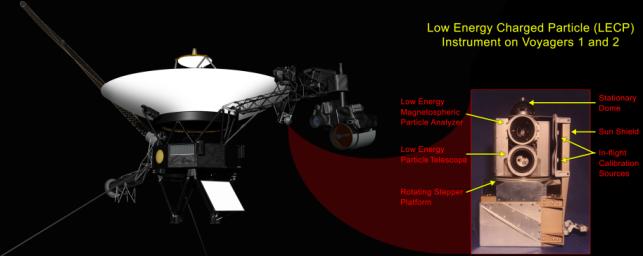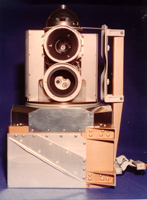
|
Location of Low-Energy Charged Particle Instrument
- Click the image above for a larger view
- Full-Res JPEG (3240 x 1291) (251.3 kB)
- Full-Res TIFF (3240 x 1291) (12.6 MB)
Caption:

Low-energy Charged Particle Instrument
Click on the image for larger version
This graphic shows the NASA's Voyager 1 spacecraft and the location of its low-energy charged particle instrument. A labeled close-up of the low-energy charged particle instrument appears as the inset image.
The instrument includes a stepper motor that turns the platform on which the sensors are mounted, so that the field of view rotates through 360 degrees. This motor was tested for 500,000 steps, enough to reach the orbit of Saturn, and has now completed over 6 million steps. The old-fashioned capacitor bank underneath the motor stores energy needed to provide a 15.7-watt pulse every 192 seconds.
Background Info:
The Voyager spacecraft were built and continue to be operated by NASA's Jet Propulsion Laboratory, in Pasadena, Calif. Caltech manages JPL for NASA. The Voyager missions are a part of NASA's Heliophysics System Observatory, sponsored by the Heliophysics Division of the Science Mission Directorate at NASA Headquarters in Washington.
For more information about the Voyager spacecraft, visit:
http://www.nasa.gov/voyager
and
http://voyager.jpl.nasa.gov
.
Cataloging Keywords:
| Name | Value | Additional Values |
|---|---|---|
| Target | Saturn | |
| System | ||
| Target Type | Planet | |
| Mission | Voyager | |
| Instrument Host | Voyager 1 | |
| Host Type | Flyby Spacecraft | |
| Instrument | Low-Energy Charged Particle Instrument (LECP) | |
| Detector | ||
| Extra Keywords | Color, Rotation | |
| Acquisition Date | ||
| Release Date | 2012-12-03 | |
| Date in Caption | ||
| Image Credit | NASA/JPL-Caltech/JHUAPL | |
| Source | photojournal.jpl.nasa.gov/catalog/PIA16484 | |
| Identifier | PIA16484 | |
